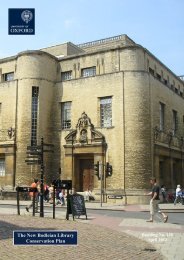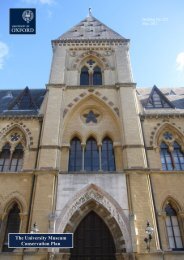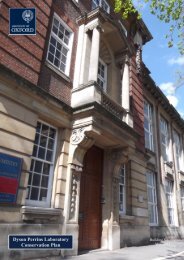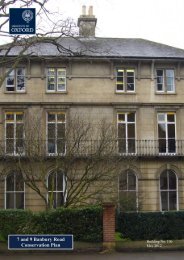The Sheldonian Theatre Conservation Plan - Central Administration ...
The Sheldonian Theatre Conservation Plan - Central Administration ...
The Sheldonian Theatre Conservation Plan - Central Administration ...
Create successful ePaper yourself
Turn your PDF publications into a flip-book with our unique Google optimized e-Paper software.
1 INTRODUCTION<br />
<strong>The</strong> <strong>Sheldonian</strong> <strong>The</strong>atre was designed by Sir Christopher Wren and was built between<br />
1664 and 1669. It is a Grade I listed building and was described in 1994 by the<br />
European Commission as ‘one of the architectural jewels of Oxford’. <strong>The</strong> theatre is a<br />
functioning building, having operated as the primary assembly room of the University<br />
of Oxford since its construction, and recent redecoration work has restored the interior<br />
to something akin to its original character.<br />
1.1 Purpose of the <strong>Conservation</strong> <strong>Plan</strong><br />
<strong>The</strong> University has an unrivalled portfolio of historic buildings, of which it is rightly<br />
proud. It has traditionally taken a thorough, holistic approach to building<br />
conservation, seeking to understand all the varied factors that make historic buildings<br />
significant to their diverse stakeholders, and using this to inform necessary change. It<br />
has become clear that this approach is vital to the conservation culture of an<br />
institution where so many of its historic buildings that are valued for their function<br />
also have extensive historical or architectural significance. This <strong>Conservation</strong> <strong>Plan</strong><br />
represents the continuation of this tradition of seeking to understand what makes the<br />
University’s buildings cherished assets, and of seeking ways to conserve these most<br />
important features for the enjoyment of future generations.<br />
<strong>The</strong> success of this approach is such that it has now become codified in government<br />
policy: First in March 2010’s <strong>Plan</strong>ning Policy Statement 5: <strong>Plan</strong>ning for the<br />
Historical Environment then in its replacement, March 2012’s National <strong>Plan</strong>ning<br />
Policy Framework (hereafter: NPPF). NPPF provides useful guidance on approaching<br />
the conservation of heritage assets, and postdates the University’s existing literature.<br />
NPPF defines a heritage asset as:<br />
‘A building, monument, site, place, area or landscape identified as having a degree of<br />
significance meriting consideration in planning decisions, because of its heritage<br />
interest. Heritage asset includes designated heritage assets and assets identified by<br />
the local planning authority (including local listing).’<br />
This designation clearly applies to the <strong>Sheldonian</strong> <strong>The</strong>atre.<br />
<strong>The</strong> purpose of this <strong>Conservation</strong> <strong>Plan</strong> is to update the <strong>Sheldonian</strong> <strong>The</strong>atre’s<br />
conservation policy to take into account the new guidance provided by NPPF. It will<br />
be of use both for informing responsible regular maintenance and in the preparation of<br />
future planning applications, as specified in NPPF paragraph 128.<br />
<strong>The</strong> <strong>Conservation</strong> <strong>Plan</strong> should form the basis for the <strong>Sheldonian</strong> <strong>The</strong>atre’s<br />
<strong>Conservation</strong> Policy and exists as part of an ongoing process. It will be renewed and<br />
updated at least every five years or following any major alterations or legislative<br />
changes.<br />
<strong>Sheldonian</strong> <strong>The</strong>atre,<br />
<strong>Conservation</strong> <strong>Plan</strong>, May 2012<br />
5

















